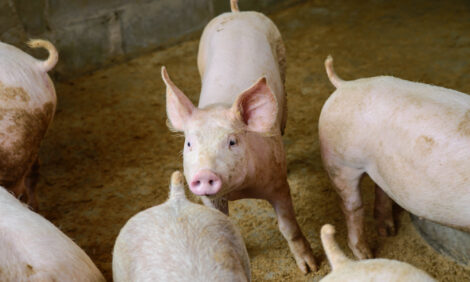



Pork Exports Continue to Exceed 2007 Pace
US - Red meat exports continued their strong pace through November, with pork up 20 per cent and beef up nine per cent (including variety meat) compared to November 2007.For the first 11 months of 2008, pork and pork variety meat exports were 61 per cent larger than 2007, nearing the 2 million metric ton mark (1,898,698 metric tons or 4.18 billion pounds). 2008 pork exports through 11 months were valued at $4.5 billion, an increase of 59 per cent.
“Global protein supplies remain tight, with the exception of a few situations in key countries where stocks of imported red meat are weighing on the market, specifically in Korea and China,” said Erin Daley, US Meat Export Federation (USMEF) economist. “As currencies and prices stabilize, inventories will decline and demand for US red meat will likely continue at a relatively strong level. Although pork exports are not expected to maintain the stunning pace of 2008, they are forecast to exceed 2007 volumes,” Daley said.
“The bottom line is that, regardless of the global economic situation, people have to eat,” said Daley. “US beef and pork prices are lower than they were during the summer, which helps offset the increased strength of the US of the dollar.”
Despite the slowing of global trade in all products, pork exports from the major suppliers, the European Union (EU), the US and Canada, remained fairly steady from September through November. Pork exports from Brazil, however, declined by 50 per cent in November, and its beef exports fell 35 per cent compared to November 2007. Reduced exports to Russia and Hong Kong account for most of the decline. Australia’s beef exports remained strong from September through November, largely due to an increase in exports to the United States, with US import demand stimulated by the strengthening US dollar.
Pork Exports
For the first 11 months of the year, exports of pork and pork variety meat accounted for nearly 25 per cent of production, with export value equating to $43 per head slaughtered compared to less than $30 per head during the same period in 2007, Daley said.
“Pork remains a very affordable protein, and our exports continue to defy projections,” said Daley.
Mexico was the top pork export market in November, reaching another new record at 41,402 metric tons (91.3 million pounds), up 50 per cent from November 2007. January through November exports to Mexico increased 40 per cent to 348,458 metric tons (768.2 million pounds) valued at $614.2 million.
Japan was the second-largest market in November with exports at 40,354 metric tons (88.9 million pounds), up 22 per cent. January through November, Japan was still the largest destination for US pork, with exports were up 27 per cent to 417,986 metric tons (921.5 million pounds) valued at $1.43 billion. Although the strong yen has unique implications for pork exports, due to the gate price system, exports are expected to remain strong in 2009 especially as the US is the dominant supplier of chilled pork.
The China/Hong Kong region was the third-largest market for US pork in November, with exports totaling 19,469 metric tons (42.9 million pounds), primarily to Hong Kong. Muscle cuts accounted for 8,747 metric tons (19.3 million pounds). November exports to this region were the smallest monthly volume since December 2007 and were 17 per cent lower than November 2007. Still, Daley noted that January through November exports were up 148 per cent, totaling 377,431 metric tons (832.1 million pounds) valued at $652.6 million. Large supplies of imported pork are weighing on the market, compounded with the increase in Chinese production. Although it is difficult to predict the pace of exports to the region in 2009, US pork will benefit from the wide exposure to the product during the massive shipments in 2008.
November exports to Russia were off 8 per cent from November 2007, totaling 14,613 metric tons or 32.2 million pounds (muscle cuts accounted for 8,840 metric tons or 19.5 million pounds). January through November exports to Russia were up 141 per cent and totaled 214,960 metric tons (473.9 million pounds) including 148,552 metric tons (327.5 million pounds) of muscle cuts valued at $469.3 million. In 2008, muscle cut exports to Russia exceeded the US tariff rate quota (TRQ) of 49,800 metric tons (109.8 million pounds) by more than 100,000 metric tons (220.5 million pounds). In other words, more than 100,000 metric tons of US pork entered Russia subject at a duty of 60 per cent.
As recently reported by USMEF, the US TRQ for pork exports to Russia increased to 100,000 metric tons ( 220.5 million pounds) for 2009, which will be beneficial, especially considering oil priced at approximately $40/barrel and the global economic situation. It may be difficult to export large volumes of pork outside the TRQ this year, so a doubling of the quota size was critically important, Daley noted.
Pork exports to Canada set a new monthly record in November at 17,474 metric tons (38.5 million pounds), up 8 per cent from November 2007. January through November exports were up 17 per cent totaling 157,146 metric tons (346.4 million pounds) valued at $514.27 million.
“Exports were surprisingly strong considering the weakening of the Canadian dollar and the slowing of live hog exports to the US (imports of Canadian slaughter hogs were down 38 per cent during 2008),” said Daley. “Hopefully the revisions to COOL in the recently published rule will result in more favorable trade with Canada and Mexico.”
Exports to South Korea were steady at 10,712 metric tons (23.6 million pounds), putting the January through November total up 42 per cent to 122,997 metric tons (271.2 million pounds) valued at $262.9 million. Pork exports to Korea should remain strong, as an affordable protein with a positive image.

Other Pork Export Markets
- ASEAN region – exports up 173 per cent to 4,361 metric tons (9.6 million pounds) in November. January through November total at 54,840 metric tons (120.9 million pounds), an increase of 328 per cent. The Philippines, Vietnam and Singapore are the largest markets. Recent exports to Vietnam have declined dramatically due to large supplies and low prices in China, but exports to the Philippines and Singapore remain significantly larger than historical levels.
- European Union – up 127 per cent to 4,584 metric tons (10.1 million pounds) in November. January through November totals up 146 per cent to 44,764 metric tons (98.7 million pounds).
- Australia – up 64 per cent in November, totaling 3,123 metric tons (6.9 pounds) with a January through November increase of 36 per cent to 38,176 metric tons (84.2 million pounds). Exports to New Zealand were up 17 per cent, totaling 6,040 metric tons (13.3 million pounds) through November.
- Central and South America – up 30 per cent to 5,001 metric tons (11 million pounds) with exports up 22 per cent through November, totaling 36,465 metric tons (80.4 million pounds). Honduras is the largest market, followed by Colombia and Guatemala.
- Caribbean (excluding the Dominican Republic) – up 77 per cent to 3,025 metric tons (6.7 million pounds) in November with exports up 21 per cent through November, totaling 18,228 (40.2 million pounds).
- Dominican Republic – up 103 per cent to 1,127 metric tons (2.5 million pounds) in November, putting the January through November total at 12,453 metric tons (27.5 million pounds), up 158 per cent.
- Taiwan – up 89 per cent through November, totaling 28,735 metric tons (63.3 million pounds).








